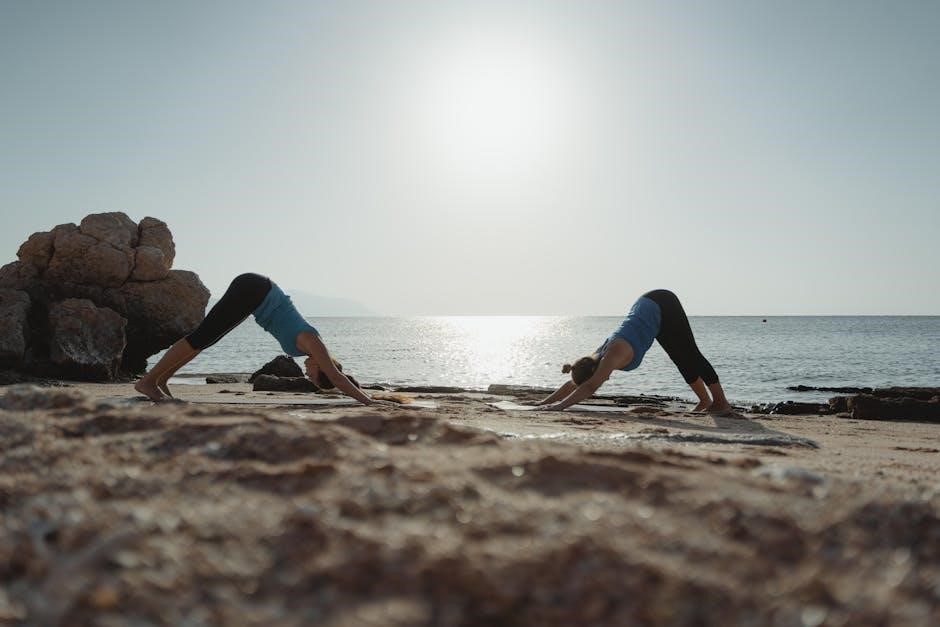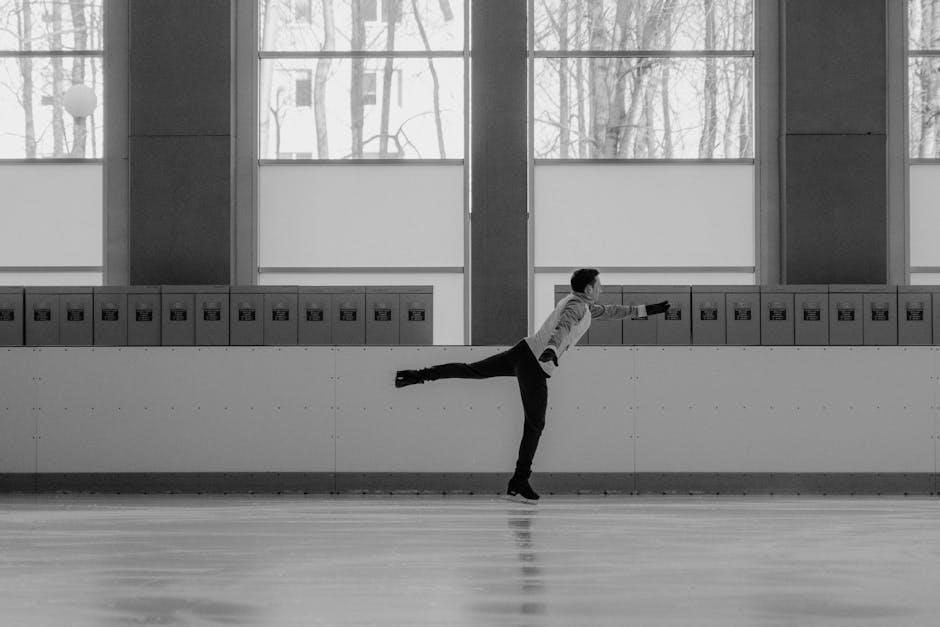TRE (Tension or Trauma Release Exercises) are a series of movements designed to release deep muscular tension and trauma. Developed by Dr. David Berceli, TRE helps individuals naturally restore balance and resilience by targeting the psoas muscles. These exercises are increasingly popular in modern wellness for their ability to promote relaxation and emotional well-being through gentle, repetitive motions.
1.1 What Are TRE Exercises?
TRE (Tension or Trauma Release Exercises) are a series of movements designed to help individuals release deep muscular tension and trauma. Developed by Dr. David Berceli, TRE focuses on activating the body’s natural response to stress and trauma, particularly in the psoas muscles. These exercises involve gentle, repetitive movements that encourage the release of stored tension, promoting relaxation and resilience. TRE is based on the idea that the body stores stress and trauma in its muscles, and by engaging in specific stretches and movements, individuals can safely release these patterns. This practice is widely used to address physical, emotional, and psychological stress, making it a valuable tool for overall well-being.
1.2 Origin and Development of TRE
TRE (Tension or Trauma Release Exercises) was developed by Dr. David Berceli, an expert in trauma recovery, based on his extensive work with survivors of trauma worldwide. Drawing from his understanding of the body’s natural responses to stress and trauma, Berceli created a series of exercises that target the psoas muscles, a key area where tension is often stored. The exercises involve seven core movements designed to activate the body’s innate tremor mechanism, which helps release stored tension and trauma. TRE has gained global acceptance as a safe and effective method for promoting physical and emotional healing. It is widely practiced today, with resources like TRE exercises PDF guides making it accessible to individuals seeking to learn and benefit from this powerful practice.
1.3 Importance of TRE in Modern Wellness
TRE has become a vital component of modern wellness due to its ability to address the growing prevalence of stress, tension, and trauma in contemporary life. In today’s fast-paced world, where mental and physical strain are common, TRE offers a natural, non-invasive method to release stored tension and promote relaxation. Its simplicity and effectiveness make it accessible to individuals from all walks of life, providing a tool for self-care and emotional resilience. TRE exercises, often shared through downloadable PDF guides, empower individuals to take charge of their well-being, making it a cornerstone of holistic health practices. By focusing on the body’s innate healing mechanisms, TRE aligns with the modern emphasis on preventive and integrative health solutions.

Benefits of TRE Exercises
TRE exercises offer profound benefits, including stress relief, muscle relaxation, and enhanced emotional well-being. They help release stored tension, promoting resilience and overall health through natural, gentle movements.

2.1 Stress Relief and Tension Release

TRE exercises are highly effective for stress relief and tension release. By activating the body’s natural tremor mechanism, TRE helps release deep muscular tension stored from daily stress or traumatic experiences. This process promotes relaxation, reduces muscle tightness, and calms the nervous system. Regular practice can lower cortisol levels, improve sleep quality, and enhance emotional resilience. Many find TRE exercises particularly beneficial for managing chronic stress, as they provide a safe, drug-free method to unwind and recharge. Incorporating TRE into your routine can lead to a significant reduction in both physical and mental tension, fostering a sense of calm and well-being. This makes TRE an excellent complement to other stress-relief practices like meditation or yoga.
2.2 Improving Muscle Relaxation
TRE exercises are renowned for their ability to improve muscle relaxation by releasing stored tension in the body. The tremor response activated during these exercises helps discharge pent-up energy in the muscles, leading to a deep sense of relaxation. Regular practice can reduce muscle tightness, improve circulation, and enhance flexibility. Over time, TRE helps the body transition from a state of hyperarousal to one of calm and ease. This makes it particularly beneficial for individuals with chronic muscle tension or those recovering from physical strain. By addressing the root cause of tension, TRE promotes long-term muscle relaxation and overall physical comfort, allowing for better movement and reduced muscle soreness in daily activities.
2.3 Enhancing Emotional Well-Being
TRE exercises have a profound impact on emotional well-being by releasing deep-seated tension and promoting a sense of calm. The rhythmic tremors induced during practice help quiet the nervous system, reducing anxiety and stress. This neurophysiological response allows the body to release stored emotional trauma, fostering a greater sense of balance and resilience. Regular TRE practice can lead to improved mood, reduced emotional reactivity, and enhanced self-awareness. By addressing the interconnection between physical and emotional tension, TRE provides a safe and natural way to process emotions, leading to a more stable and peaceful mental state. This makes it an invaluable tool for anyone seeking to improve their emotional health and overall quality of life.

How to Perform TRE Exercises
Start with light stretching to prepare your muscles. Find a comfortable position, either lying down or sitting. Engage in gentle movements like leg lifts or arm extensions, focusing on deep breathing to relax your muscles. Follow step-by-step guides from TRE exercises PDFs, such as swaying side to side or lifting legs slowly. Practice daily, even briefly, to see benefits over time. Listen to your body and stop if pain occurs. Consider combining TRE with mindfulness or yoga for enhanced effects. Stay consistent and patient, as benefits may vary from immediate to gradual.
3.1 Preparation and Safety Guidelines
Before starting TRE exercises, consult a healthcare professional, especially if you have injuries or chronic conditions. Create a safe, quiet space to practice without distractions. Wear loose, comfortable clothing and use a mat for support. Begin slowly, as TRE can release deep tension, and gradually increase intensity. Stay hydrated before, during, and after practice. Listen to your body and stop if discomfort arises. Avoid forcing movements beyond your range of motion. Practice on an empty stomach or light meal to enhance relaxation. Keep a first-aid kit nearby and ensure proper ventilation in the room. Follow guidelines from TRE exercises PDFs to maintain safety and effectiveness. Prioritize breathing techniques to deepen relaxation and prevent strain.
3.2 Step-by-Step Guide to Basic TRE Movements
Start with the foundational TRE movement: the spinal shake. Stand with feet hip-width apart, knees slightly bent, and arms relaxed. Gently bounce, allowing your spine to release tension naturally. Next, move into the cat-cow stretch: on hands and knees, arch your back (cow) and then round it (cat), repeating slowly. Progress to the psoas release by lying on your back, bringing one knee toward your chest, and gently rocking. Finally, incorporate neck and shoulder rolls to release upper body tension. Perform each movement slowly, focusing on relaxation. Follow the sequence outlined in TRE exercises PDFs for proper form and progression. Practice at your own pace, allowing your body to release tension naturally without force. Consistency is key to mastering these foundational movements.
3.3 Integrating TRE into Daily Routine
Incorporating TRE into your daily routine can enhance its benefits. Start with short, 10-15 minute sessions and gradually increase as you become comfortable. Ideal times are in the morning to energize or evening to unwind. Create a quiet, comfortable space free from distractions. Begin with basic movements, like the spinal shake, and slowly add more as you progress. Customize your practice to fit your schedule, even breaking it into shorter segments if needed. Consistency is key, so aim to practice at the same time daily. Modify movements to suit your fitness level and track your progress. End each session with deep breathing to promote relaxation. For detailed routines, refer to TRE exercises PDFs, which often include schedules and tips for seamless integration.

TRE Exercises PDF Resources
TRE exercises PDFs are comprehensive guides offering detailed instructions, diagrams, and tips for mastering TRE movements. They provide customizable routines and tracking tools to enhance your practice effectively.
4.1 Recommended PDF Guides for Beginners
For those new to TRE exercises, beginner-friendly PDF guides are essential. These resources typically include step-by-step instructions, diagrams, and safety tips to ensure a smooth start. Many guides are designed to be easy to follow, with clear explanations of each movement and its benefits. They often emphasize proper posture, breathing techniques, and pacing to prevent discomfort. Some PDFs also include modified exercises for individuals with physical limitations. These guides are perfect for building a strong foundation and gradually progressing in TRE practice. They are usually concise, visually appealing, and accessible for anyone looking to incorporate TRE into their wellness routine. Starting with a beginner’s guide ensures a safe and effective introduction to the exercises.
4.2 Advanced TRE Workout PDFs
Advanced TRE workout PDFs are tailored for individuals who have mastered the foundational movements and seek to deepen their practice. These guides often feature complex exercises, detailed anatomical explanations, and advanced techniques to target specific muscle groups or emotional blockages. They may include dynamic stretches, prolonged shaking protocols, and specialized sequences for enhanced energy release. Many advanced PDFs incorporate mindfulness practices, breathwork, and meditation to amplify the benefits of TRE. These resources are ideal for practitioners looking to challenge themselves and explore the full potential of TRE. They typically assume prior knowledge of basic TRE principles, allowing for a more intensive and transformative experience. Advanced PDFs are a valuable tool for those committed to long-term growth and self-healing through TRE.
4.3 How to Choose the Right TRE PDF
Selecting the right TRE exercises PDF depends on your skill level, goals, and preferences. Begin by assessing whether you are a beginner or advanced practitioner, as this will guide your choice. Look for PDFs with clear, step-by-step instructions and visual aids like diagrams or photos. Ensure the content aligns with your objectives, such as stress relief, muscle relaxation, or emotional well-being. Check for user reviews or recommendations to gauge the PDF’s effectiveness and clarity. Additionally, consider whether the PDF focuses on specific techniques or combines TRE with other practices. Finally, verify that the resource is updated and relevant to current TRE methodologies. By evaluating these factors, you can find a PDF that enhances your TRE practice and supports your wellness journey effectively.

Advanced TRE Techniques
Advanced TRE techniques offer enhanced movements and expert guidance for improved results. They help refine your practice and achieve deeper relaxation and emotional balance.
5.1 Combining TRE with Other Therapies
Combining TRE with other therapies can enhance its benefits and create a holistic approach to wellness. For instance, integrating TRE with yoga or mindfulness practices can deepen relaxation and emotional balance. Physical therapies, such as chiropractic care or massage, can complement TRE by addressing structural misalignments and improving muscle release. Additionally, pairing TRE with breathwork or meditation can amplify its stress-relieving effects. Many TRE exercises PDF guides offer insights into how to blend these practices safely and effectively. This combination not only accelerates progress but also tailors the approach to individual needs, making it a powerful tool for overall well-being.
5.2 Customizing TRE for Specific Needs
Customizing TRE exercises allows individuals to tailor the practice to their unique requirements, ensuring maximum effectiveness. Whether addressing physical limitations, targeting specific muscle groups, or focusing on emotional release, TRE can be adapted to suit various needs. For example, athletes may emphasize dynamic movements to enhance performance, while those with chronic pain might prioritize gentle, restorative tremors. TRE exercises PDF guides often provide modifications and variations, enabling users to adjust the intensity and focus of their practice. This flexibility makes TRE accessible to a wide range of individuals, from beginners to advanced practitioners, ensuring a personalized and transformative experience.
5.3 Mastering Complex TRE Movements
Mastering complex TRE movements requires patience, dedication, and a deep understanding of the practice. Advanced techniques involve intricate combinations of tremors, breathwork, and muscle engagement, which can amplify the release of tension and enhance overall well-being. Practitioners should focus on progressing gradually, ensuring proper form and alignment to avoid discomfort or injury. Controlled breathing and mindful awareness are essential for executing complex movements effectively. Regular practice and feedback from experienced instructors can help refine skills and deepen the benefits of TRE. By mastering these advanced movements, individuals can unlock new levels of physical and emotional release, making their TRE practice even more transformative and impactful.

Troubleshooting Common Issues
TRE practices can sometimes present challenges like initial discomfort or difficulty in maintaining tremors. Listening to your body and adjusting movements can help alleviate these issues effectively.

6.1 Overcoming Initial Discomfort
Initial discomfort during TRE exercises is common, especially for beginners. To address this, start with gentle movements and gradually increase intensity. Deep breathing can help relax the body and reduce tension. If pain arises, stop the exercise immediately and consult a professional. Modifying the exercises to suit your physical limitations is also crucial. Prioritize awareness of your body’s signals and avoid pushing beyond what feels safe. Consistency is key, but so is listening to your body. Additionally, using TRE exercises PDF guides can provide structured routines to ease into practice comfortably. Patience and self-compassion are essential for overcoming initial challenges and enjoying long-term benefits.
6.2 Addressing Physical Limitations
Physical limitations can be a barrier to performing TRE exercises effectively. To address this, consult with a healthcare professional or certified TRE practitioner to adapt movements to your needs. Many TRE exercises PDF guides offer modified versions of exercises for individuals with mobility challenges. Start with slower, smaller movements and avoid forcing your body beyond its capacity. Breathing techniques can also enhance the experience without straining. Prioritize gentle transitions and focus on relaxation rather than intensity. By listening to your body and making necessary adjustments, you can safely incorporate TRE into your routine, even with physical limitations. This approach ensures a beneficial and injury-free practice.
6.3 Maintaining Consistency in Practice
Maintaining consistency in TRE practice is crucial for maximizing its benefits. Start by setting a realistic schedule, such as practicing 2–3 times a week, and gradually increase frequency as it becomes a habit. Use a TRE exercises PDF guide to create a structured routine, ensuring you follow the recommended sequence and duration. Track your progress in a journal to stay motivated and identify patterns. Begin with short sessions and slowly extend them as your body adapts. Remember, consistency is more important than intensity. Even small, regular practices yield better results than irregular, prolonged sessions. Stay patient and celebrate small milestones to keep your practice sustainable and enjoyable over time.
TRE exercises offer profound benefits for stress relief, muscle relaxation, and emotional well-being. Using a TRE exercises PDF guide ensures structured practice. Embrace consistency and enjoy the transformative results.
7.1 Summary of Key Benefits
TRE exercises, as detailed in a TRE exercises PDF, are a powerful tool for enhancing physical and emotional health. They promote deep relaxation, reduce chronic stress, and improve flexibility. By releasing stored tension, TRE fosters better posture, reduces pain, and enhances overall well-being. Regular practice strengthens the mind-body connection, boosting resilience and emotional balance. The structured routines in TRE guides ensure safe and effective practice, making them accessible to all skill levels. Whether you’re seeking relief from stress or improving physical mobility, TRE exercises offer a holistic approach to wellness. Incorporating a TRE exercises PDF into your routine provides a clear roadmap for achieving these benefits consistently.
7.2 Encouragement for Continuous Practice
Consistency is key to experiencing the full benefits of TRE exercises. Regular practice helps build resilience, reduces stress, and enhances overall well-being. Even small, daily efforts can lead to significant improvements over time. Remember, TRE is a journey, and patience is essential. Initial discomfort may arise, but it’s a sign of progress. Stay committed, and you’ll notice increased relaxation, better posture, and improved emotional balance. Utilize TRE exercises PDF guides to stay motivated and structured in your practice. Celebrate small victories and remind yourself of the long-term benefits. With dedication, TRE can become a transformative part of your wellness routine, fostering a healthier, happier you.
7.3 Final Tips for Effective TRE Practice
To maximize the benefits of TRE exercises, prioritize consistency and patience. Start with short sessions and gradually increase duration as your body adapts. Use TRE exercises PDF guides to ensure proper form and technique. Practice on a mat or soft surface for comfort and safety. Focus on deep, natural breathing to enhance relaxation. Avoid forcing movements; let your body release tension naturally. Create a calming environment, such as dim lighting or soothing music, to deepen your practice. Set realistic goals and track progress to stay motivated. Celebrate small milestones, like increased flexibility or reduced stress, to reinforce your commitment. Remember, TRE is a personal journey—listen to your body and honor its needs. With dedication and the right resources, you can unlock the full potential of TRE for long-term well-being.

Additional Resources
Explore our curated list of TRE exercises PDFs, featuring detailed guides and tutorials. Enhance your practice with additional resources, including websites, videos, and expert-led workshops, to deepen your understanding and stay updated on the latest techniques.
8.1 Suggested Reading and Websites
For a deeper understanding of TRE exercises, explore reputable websites like TraumaReleasing.com and TRElosophy.com, which offer comprehensive guides and PDF resources. Check out books like The Revolution of TRE by Dr. David Berceli, available in digital formats. Visit TREinstitute.com for detailed manuals and research-based articles. Additionally, YouTube channels such as TRE Exercises Official provide video tutorials and PDF downloads. Don’t miss blogs like TRE for Stress Relief and Healing Through Movement, which share insights and downloadable resources. These platforms ensure you have access to reliable materials to enhance your TRE practice and understanding.
8.2 Recommended Videos and Tutorials
Enhance your TRE practice with high-quality video resources available on platforms like YouTube and Vimeo. Channels such as TRE Exercises Official and Dr. David Berceli provide detailed demonstrations of TRE movements. For structured learning, explore courses on Udemy and Coursera, which often include downloadable PDF guides. Additionally, websites like TREtraining.com and TheTRECenter.com offer tutorials and instructional videos designed for both beginners and advanced practitioners. These resources are perfect for visual learners, ensuring proper form and technique. Many videos also include tips for modifying exercises based on individual needs, making them accessible to a wide audience. Utilize these tools to deepen your understanding and improve your TRE practice effectively.
8.3 Joining TRE Communities and Forums
Connecting with TRE communities and forums can enrich your practice and provide invaluable support. Platforms like Facebook Groups and specialized forums host active discussions where practitioners share experiences and tips. Groups such as TRE Global and TRE Enthusiasts offer a space to ask questions, learn from others, and gain insights into optimizing your practice. Many communities also host live workshops, webinars, and Q&A sessions with certified TRE instructors. Engaging with these networks can help you stay motivated, address challenges, and connect with like-minded individuals. Additionally, some forums provide access to exclusive resources, including PDF guides and troubleshooting tips. Joining these communities fosters a sense of belonging and ensures you stay updated on the latest TRE techniques and advancements.